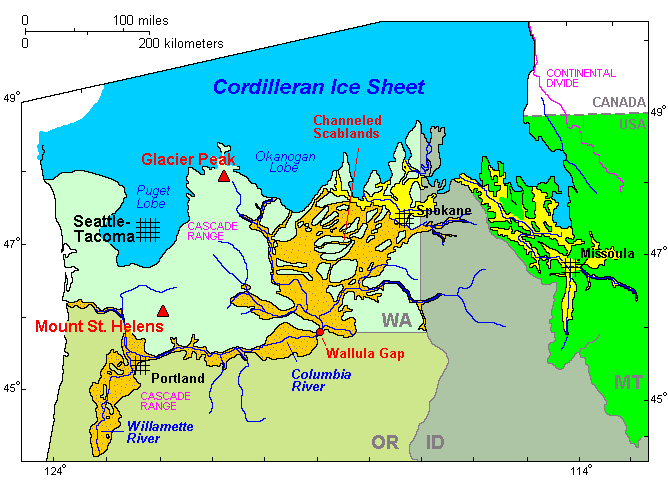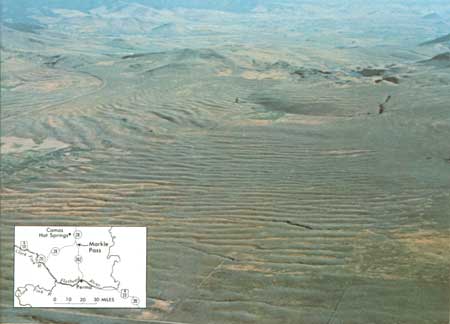|
Touchet Formation
The Touchet Formation or Touchet beds consist of large quantities of gravel and fine sediment which overlay almost a thousand meters (several thousand feet) of volcanic basalt of the Columbia River Basalt Group in south-central Washington (U.S. state), Washington and north-central Oregon. The beds consist of between 6 and 40 distinct rhythmites – horizontal layers of sediment, each clearly demarcated from the layer below. These Touchet beds are often covered by aeolian processes, windblown loess soils which were deposited later; the number of layers varies with location. The beds vary in depth from at lower elevations where a number of layers can be found to a few extremely thin layers at the maximum elevation where they are observed (). The Touchet beds are one element in a chain of evidence which helped identify and define the progression of the Missoula Floods, which occurred around 16,450 to 13,750 years Common Era, BCE. During the floods, flow through the Wallula Ga ... [...More Info...] [...Related Items...] OR: [Wikipedia] [Google] [Baidu] |
Sediment
Sediment is a naturally occurring material that is broken down by processes of weathering and erosion, and is subsequently transported by the action of wind, water, or ice or by the force of gravity acting on the particles. For example, sand and silt can be carried in suspension in river water and on reaching the sea bed deposited by sedimentation; if buried, they may eventually become sandstone and siltstone ( sedimentary rocks) through lithification. Sediments are most often transported by water ( fluvial processes), but also wind (aeolian processes) and glaciers. Beach sands and river channel deposits are examples of fluvial transport and deposition, though sediment also often settles out of slow-moving or standing water in lakes and oceans. Desert sand dunes and loess are examples of aeolian transport and deposition. Glacial moraine deposits and till are ice-transported sediments. Classification Sediment can be classified based on its grain size, grain s ... [...More Info...] [...Related Items...] OR: [Wikipedia] [Google] [Baidu] |
Channeled Scablands
The Channeled Scablands are a relatively barren and soil-free region of interconnected relict and dry flood channels, coulees and cataracts eroded into Palouse loess and the typically flat-lying basalt flows that remain after cataclysmic floods within the southeastern part of Washington.Neuendorf, K.K.E., J.P. Mehl, Jr., and J.A. Jackson, eds. (2005) ''Glossary of Geology'' (5th ed.). Alexandria, Virginia, American Geological Institute. 779 pp. The Channeled Scablands were scoured by more than 40 cataclysmic floods during the Last Glacial Maximum and innumerable older cataclysmic floods over the last two million years. These floods were periodically unleashed whenever a large glacial lake broke through its ice dam and swept across eastern Washington and down the Columbia River Plateau during the Pleistocene epoch. The last of the cataclysmic floods occurred between 18,200 and 14,000 years ago.Balbas, A.M., Barth, A.M., Clark, P.U., Clark, J., Caffee, M., O'Connor, J., Baker, ... [...More Info...] [...Related Items...] OR: [Wikipedia] [Google] [Baidu] |
Tucannon River
The Tucannon River is a tributary of the Snake River in the U.S. state of Washington. It flows generally northwest from headwaters in the Blue Mountains of southeastern Washington to meet the Snake upstream from Lyons Ferry Park and the mouth of the Palouse River. The Tucannon is about long. Part of the upper river flows through the Wenaha–Tucannon Wilderness. Watershed The Tucannon basin of ranges in elevation from about above sea level at the mouth on the Snake River to about in the Umatilla National Forest of the Blue Mountains. River flows in the Tucannon basin depend solely on precipitation and groundwater. Studies in the early 1990s suggested that these flows would not be able to meet all of the claims, public and private, on the water resources of the lower river. In particular, farm irrigation projects were competing with fisheries for limited water. The Washington Department of Ecology named the Tucannon basin a Watershed Resource Inventory Area (WRIA) and in 199 ... [...More Info...] [...Related Items...] OR: [Wikipedia] [Google] [Baidu] |
Touchet River
The Touchet River is a tributary of the Walla Walla River in southeastern Washington in the United States. The Touchet River drains an area of about in Columbia County and Walla Walla County.Washington Road & Recreation Atlas, Benchmark Maps, Medford, Oregon, 2002 The upper Touchet was a traditional summer meeting place for trade and games for the Palus, Nez Perce and Walla Walla tribes. The name Touchet derives from the similarly pronounced Sahaptin term for the river, ''Tu-se'' meaning roasting. Nez Perce legend tells that coyote roasted salmon at this river after breaking a fish dam guarded by the seven swallow sisters at Celilo. The USGS cited two variant names, Pouchet River and Toosha River. Geography The Touchet River is formed by several forks draining the north slope of the Blue Mountains above Dayton in Columbia County. All the forks have their head in the Walla Walla Ranger District of the Umatilla National Forest. The North Fork, about long, begins near Sk ... [...More Info...] [...Related Items...] OR: [Wikipedia] [Google] [Baidu] |
Walla Walla River
The Walla Walla River is a tributary of the Columbia River, joining the Columbia just above Wallula Gap in southeastern Washington in the United States. The river flows through Umatilla County, Oregon, and Walla Walla County, Washington. Its drainage basin is in area.Walla Walla Subbasin Plan Northwest Power and Conservation Council Course The headwaters of the Walla Walla River lie in the Blue Mountains of northeastern . The river originates as the North and South Forks of the Walla Walla River. The surrounding forested land holds a network of hiking ...[...More Info...] [...Related Items...] OR: [Wikipedia] [Google] [Baidu] |
Yakima River
The Yakima River is a tributary of the Columbia River in south central and eastern Washington state, named for the indigenous Yakama people. Lewis and Clark mention in their journals that the Chin-nâm pam (or the Lower Snake River Chamnapam Nation) called the river ''Tâpe têtt'' (also rendered ''Tapteete''), possibly from the French ''tape-tête'', meaning "head hit". The length of the river from headwaters to mouth is , with an average drop of . It is the longest river entirely in Washington state. Course The river rises in the Cascade Range at an elevation of at Keechelus Dam on Keechelus Lake near Snoqualmie Pass, near Easton. The river flows through that town, skirts Ellensburg, passes the city of Yakima, and continues southeast to Richland, where it flows into the Columbia River creating the Yakima River Delta at an elevation of . About 9 million years ago, the Yakima River flowed south from near Vantage to the Tri-Cities, and then turned west straight ... [...More Info...] [...Related Items...] OR: [Wikipedia] [Google] [Baidu] |
Lake Lewis
Lake Lewis was a temporary lake in the Pacific Northwest region of North America, largely formed by the Missoula Floods in about the 14th millennium B.C. Lake Lewis was formed when the restricted flow of waters from periodic cataclysmic floods from Glacial Lake Missoula, pluvial Lake Bonneville, and perhaps from subglacial outbursts, backed up through the constriction formed by the Wallula Gap in the Horse Heaven Hills (southern Washington). Water also backed up further downstream on the Columbia River between Washington and Oregon, delaying the drainage of Lake Lewis. The water remained for a period of weeks before the flood waters drained through Wallula Gap, just southeast of the Tri-Cities area. Lake Lewis reached an elevation of about above sea level (today's sea level) before subsiding. Lake Lewis also flooded the Yakima, Walla Walla, Touchet and Tucannon river valleys. Evidence for Lake Lewis Wallula Gap Wallula Gap is a large water gap through basalt anticlines in ... [...More Info...] [...Related Items...] OR: [Wikipedia] [Google] [Baidu] |
Wallula Gap
Wallula Gap () is a large water gap of the Columbia River in the northwest United States in southeast Washington. It cuts through the Horse Heaven Hills basalt anticlines in the Columbia River Basin, just south of the confluence of the Walla Walla and Columbia rivers. It has been recognized as a National Natural Landmark by the National Park Service as a site that provides an important illustration of the geological history of the United States. Geology Flood basalts In southeastern Washington, eastern Oregon, and southern Idaho, flood basalt flows of extremely fluid basaltic lava spread in all directions from long fissures, building broad fields of gently sloping lava that spread widely over great distances. Along the Snake River in Idaho, and the Columbia River in Washington and Oregon, these lava flows have been extensively exposed by erosion (with extensive displays of columnar basalt), and measure almost 2 km (1.24 mi) in total thickness. The basalts f ... [...More Info...] [...Related Items...] OR: [Wikipedia] [Google] [Baidu] |
Common Era
Common Era (CE) and Before the Common Era (BCE) are year notations for the Gregorian calendar (and its predecessor, the Julian calendar), the world's most widely used calendar era. Common Era and Before the Common Era are alternatives to the original Anno Domini (AD) and Before Christ (BC) notations used for the same calendar era. The two notation systems are numerically equivalent: " CE" and "AD " each describe the current year; "400 BCE" and "400 BC" are the same year. The expression traces back to 1615, when it first appeared in a book by Johannes Kepler as the la, annus aerae nostrae vulgaris (), and to 1635 in English as " Vulgar Era". The term "Common Era" can be found in English as early as 1708, and became more widely used in the mid-19th century by Jewish religious scholars. Since the later 20th century, BCE and CE have become popular in academic and scientific publications because BCE and CE are religiously neutral terms. They are used by others who wish to be sen ... [...More Info...] [...Related Items...] OR: [Wikipedia] [Google] [Baidu] |
Missoula Floods
The Missoula floods (also known as the Spokane floods or the Bretz floods or Bretz's floods) were cataclysmic glacial lake outburst floods that swept periodically across eastern Washington and down the Columbia River Gorge at the end of the last ice age. These floods were the result of periodic sudden ruptures of the ice dam on the Clark Fork River that created Glacial Lake Missoula. After each ice dam rupture, the waters of the lake would rush down the Clark Fork and the Columbia River, flooding much of eastern Washington and the Willamette Valley in western Oregon. After the lake drained, the ice would reform, creating Glacial Lake Missoula again. These floods have been researched since the 1920s. During the last deglaciation that followed the end of the Last Glacial Maximum, geologists estimate that a cycle of flooding and reformation of the lake lasted an average of 55 years and that the floods occurred several times over the 2,000-year period between 15,000 and 13,000 year ... [...More Info...] [...Related Items...] OR: [Wikipedia] [Google] [Baidu] |





